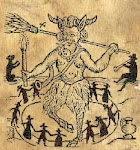(posted by Professor Peg for Billy Chew)
"It is better to hear the rebuke of the wise, than for a man to hear the song of fools."
- Ecclesiastes 7:5 (New King James Bible)
(used as a warning by many very literal Christians as a warning against Pop Music)
"This the land of the free! Why, if I say anything that displeases them, the free mob will Iynch me, and that's my freedom. Free? Why, I have never been in any country where the individual has such an abject fear of his fellow countrymen. Because, as I say, they are free to Iynch the moment he shows he is not one of them."
-D.H. Lawrence, Studies in Classic American Literature
This songwas written by Charles Manson during his brief stay with Dennis Wilson. This was obviously performed before the killing of Tate and company (1968 - just one short year, though). Although he had probably already killed.
Makes me think of that "National Treasure" exhibit put up in Washington by Condi Rice recently. Set up no doubt to debunk all the pop-theories revolving around the Nicholas Cage movie. Seems a little silly, but maybe the Catholic Church, or most churches in general, would have benefitted from doing just the same a few years ago with The Da Vinci Code, and Holy Blood, Holy Grail before that.
Americans - and maybe just human beings in general - seem obsessed with finding hidden meanings directly in front of us. Satan as a kind of "purloined letter." Charles Manson did write a Beach Boys song before disappearing off into the desert. Maybe all this paranoia's not without justification. Or maybe we're all just paranoid and stupid (see: D.H. Lawrence quote above).
Take for example, The Kingsmen's "Louie Louie",
here.
Not exactly a "purloined devil", but definitely "purloined obsenity" (whatever that means). Just a side-note, the F-word does actually show up in the original Louie Louie when the drummer messes up and yells it. If you listen, you can hear it. That's as vulgar as it gets.
But it's not just vulgarity. There's "Paul is Dead", too. Perhaps after the deaths of MLK, JFK, RFK, Malcolm X, Brian Jones, Van Morrison, Mama Cass, Jimi Hendrix, and Janis Joplin, it was only logical that a Beatle would die, too. And the world couldn't wrap its head around the fact that things were fine. So, the Beatles became a "purloined death" - ghosts on vinyl - a kind of code system explaining not only what happened to Paul, but perhaps what the Hell was going on in the world.
Suddenly, all these disparate images in Kenneth Anger don't seem so odd (let's face it, we all think they're at least ODD). We may not be the Elite, mythologically- and Crowley-read scholars he wants us to be, but we are indeed at least attempting to read into systems of symbols we're familiar with. Album art, Pop Music Lyrics. Film, too.
Just look down a ways at the Poltergeist and Exorcist business. Rosemary's Baby, too. "Cannibal Holocaust" in another way, too. A controversial, Italian exploitation film directed by Ruggero Deodato released in 1980 about (duh) cannibals. It was shot much like The Blair Witch Project in that it was about a documentary-gone wrong. Blair Witch actually blatantly stole from it.
Anyways, as Wikipedia explains:
"After premiering in Italy, the film was seized by the local Magistrate and Deodato was arrested for obscenity. He was later accused of making a snuff film based on circulating rumors that the film's actors were slain for the camera. Though Deodato would be cleared of these charges, the film was banned in Italy, the UK, Australia, and several other countries for graphic gore, sexual violence, and for the genuine slayings of six animals featured in the film. While many nations have revoked the ban, it is still banned to this day in other countries around the world."
So what do "Louie, Louie", The Da Vinci Code, National Treasure, "Paul Is Dead," Holy Blood, Holy Grail, and Cannibal Holocaust have in common? I have no idea. But I will say that we seem to enjoy reading into all these things. They're all pieces of art/consumption that we've "read into", that supposedly have more to them than meets the eye, if you can read it right. Seems occult to me.
But why do we treat them as such? They're all obviously nothing more than what they are (innocuous objects of consumption). That's a question I can't possibly answer. But it's something I've been wondering about. So I thought I'd maybe let y'all in and maybe y'all could wonder, too and maybe help me out.
http://www.factnet.org/Scientology/hollywoodsatancult.html
http://www.jesus-is-savior.com/Evils%20in%20America/Rock-n-Roll/led_zeppelin.htm
http://www.jesus-is-savior.com/Evils%20in%20America/Rock-n-Roll/imagine.htm
http://www.jesus-is-savior.com/Evils%20in%20America/devils_music.htm




















